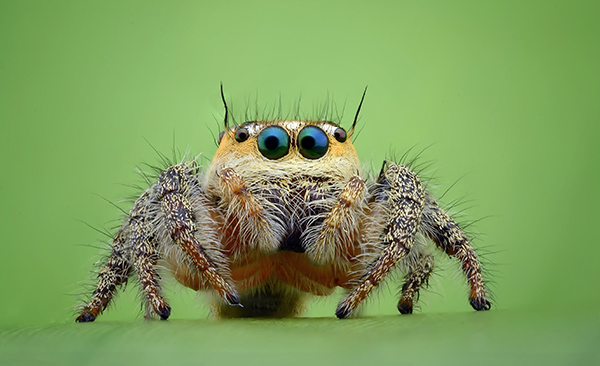How scary insects become helpful robots
The only limit to what robots can do is our imagination. But in order to make it real, we need knowledge and inspiration from many different areas. What do we need to know, for instance, in order to design a smart robot that can help in emergencies or perform heavy transports? Vision researcher Emily Baird believes that we need to study nature in order to achieve robots that work in a complex reality.
“Nature can be so unpredictable, but evolution has produced masterpieces”, says Emily Baird, researcher at the Department of Biology, Lund University. “Knowledge in biology is therefore important also when designing robots.”
Many people believe that robots can only be used for industrial or military purposes. But there is also an ongoing development of much more ingenious robots that can help people in everyday life, or transport objects in urban areas or across rough terrain. Such developments include “ambulance drones” that can fly in defibrillators, or small robots that can transport blood samples across town, and robots that can fly into places that are dangerous to humans.
Emily Baird and her colleagues within the Vision Group at Lund University draw inspiration from their studies of insects, among other things.
“I love robots that mimic insects! Many people perhaps think that insects are nasty bugs, but we can learn a lot from them as they use relatively simple solutions to fairly complex problems.”
Flying insects, such as bees and bumblebees, are robot role models. Emily Baird has studied how their vision works and how they navigate, and by doing so she contributed to the recent development of small, flying robots that can navigate independently in a highly complex environment.
“I love robots that mimic insects!”
Another amazing robot role model is the dung beetle, argues Emily Baird. These beetles are able to roll balls of dung across very uneven terrain, up and down, and around things. They are also able to transport objects that weigh more than 100 times their own body weight.
“We want to develop a robot that would be able to roll large, heavy objects across uneven terrain”, says Emily Baird. “Rolling is probably a very effective way to transport heavy objects on uneven ground – this is something for us to investigate.”
Dung beetles are interesting in the way their legs work and how they control them. Dung beetles can dig, fly and form round balls of dung which, as mentioned earlier, they are able to roll a long distance.
“We are trying to understand how dung beetles can be so flexible in what they can do with their legs.”
Certain species of dung beetles can even navigate by counting footsteps!
“We have studied a certain species which, unlike most other dung beetles, begins its search for food from its nest. This means that it must both be able to locate food and find its way back to the nest.”

Emily Baird wants to study what happens in their brains and the physical process of turning a movement into a calculation that can then be used to navigate. She and her colleagues have plans to work with a group in Germany that is good at analysing biological mechanics, as well as a group in Denmark where they can design and assemble the robots.
“We will contribute with everything we have learned about the way dung beetles navigate, how they move, and how they factor in the direction to their nest or to food. Together, we can build a dung beetle robot”, says Emily Baird.
When researchers collaborate with robot developers, this is also a way to verify their work to understand and create models of how the brain absorbs and processes visual input, and develops a behaviour.
“Robots are therefore useful both to basic research and to society”, concludes Emily Baird.
Text: Pia Romare
Photo of Emily Baird: Peter Frodin
Facts
-
Robotics research at Lund University
-
In recent decades, researchers in many different fields have worked to create robots that can become useful in society. Here are some examples of research from Lund University.
Transport robots
Studies of the vision and behaviour of insects, and how vision is used to control their behaviour, is conducted by the Lund Vision Group at the Department of Biology, which includes Emily Baird, Marie Dacke and Stanley Heinze, among others.
Social robots
The Hobbit robot is a social robot that functions as a communication tool, support and companion to elderly people. The robot was developed as part of an international project by researcher in rehabilitation engineering Håkan Eftring at Design Sciences in Lund, among others. Susanne Frennert, former doctoral student in rehabilitation engineering, has tested how the robot works in everyday situations and how elderly people interact with it.
Industrial robots
The development of new generation industrial robots involves research in automatic control, computer science, mathematics and image processing. Aspects studied include improving their properties, e.g. their fine motor skills and sensitivity, and linking these to their learning capacity.
Robots and humans
Cognitive scientists at the Department of Philosophy are trying to understand how humans and robots interact, and thereby help create robots that are capable of interaction. Their interaction with humans can be facilitated if the robots can be made to show “feelings”, for example.
Christian Balkenius runs the LUCS Robotics Group at the Division of Cognitive Science in Lund. The group is interested in how people’s vision, attention and learning capacity work in the brain and how these can be reproduced in robots. Among other things, Christian Balkenius is currently trying to develop a robot that can change the size of its iris, which is something that we humans use a lot when communicating.






